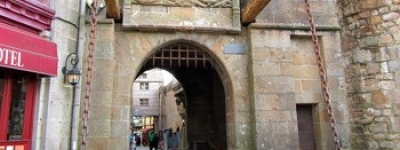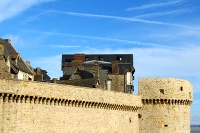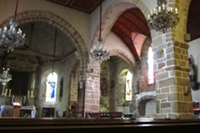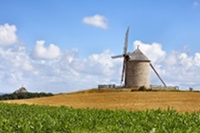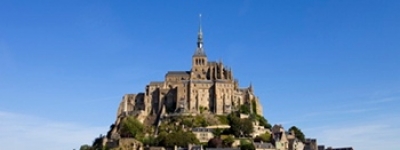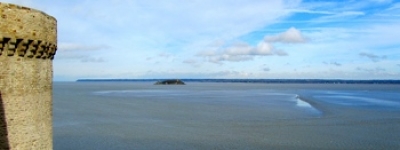Le Mont-Saint-Michel is encircled by ramparts surrounding the small village that is organized around the Grande Rue (the Main Street). The ensemble is dominated by the exceptional abbey. The village is inhabited by 40 people, half of whom are members of the religious order.
The fortifications
The fortifications of Mont-Saint-Michel were installed during the 14th and 15th centuries, and today they remain remarkably well preserved. The city was protected by walls topped with towers and bastions and pierced by three doors. The first, the Porte de l’Avancée, allows access to the monument. Its defensive system is relatively basic. The second door, the Porte du Boulevard, is better protected. And the third door, the Porte du Roy, is protected by the Arcade Tower and the Tower of the King. The defensive system is complemented by a drawbridge with a portcullis.
With this complete defensive system, the Mont-Saint-Michel was one of the most important military strongholds of the Middle Ages. In particular, the system pushed away the English during the Hundred Years War.
Though these fortifications are the work of man, Mont-Saint-Michel has a natural protection: the marshes, which isolate the monument from the continent twice a day.
The village
Once over the bridge that connects the mainland to Mont-Saint-Michel, visitors arrive at the door of the Porte de l’Avancée which opens on a first walled courtyard. On the left stands the former Corps de Garde des Bourgeois (16th century) which houses the Tourist Office. After crossing the Porte du Boulevard, the second courtyard and the Porte du Roi (15th century) with its drawbridge, its machicolations and portcullis, visitors take the Grande Rue (Main Street) which leads to the abbey. Mainly dedicated to commerce, the facades of houses that line the road feature an architecture that dates back to the 15th and 16th centuries.
Just after the Porte du Roi, the rampart path is accessible via a staircase on the right. The only street in the village, the Grande Rue revolves around the mount, leading to the foot of the ascent of the Grand Degree and the 350 steps that lead the visitor to the abbey.
If you want to avoid the crowds on Grande Rue (particularly during the summer) and the souvenir shops (just like in the Middle Ages during pilgrimages), you can access to the abbey by small alleyways that lead up the monument to the left of Grande Rue. Another possibility for directly reaching the abbey : the rampart path, which has the added advantage of offering a beautiful view of the bay.
The parish church of Saint Pierre
The Church of Saint Pierre has been the place of worship of the inhabitants of Mont-Saint-Michel for ten centuries.
Although some remains of the 11th century building are still evident in its pillars, most of the church dates from the 15th and 16th centuries. The structure of the nave is unique for its single aisle.
The church contains ritual objects of the highest order, such as the altar and altarpiece column from 1660, a Virgin and Child, a statue of the Education of the Virgin (Saint Anne teaching Mary) from the 15th and 16th centuries, and a copy of the silver statue of Saint Michael that adorns the spire of the abbey in the chapel.
In the Surrounding Area
Moulin de Moidrey
35 route des Moulins, 50170 Moidrey
Tel : 06 46 36 18 82.
Entrance: €2.50
Guided tour: full price/ reduced price : €4/ €2.50.
Open daily from February to November
February and March: 9 a.m. to 12:30 p.m. / 2 p.m. to 6 p.m. ;
July and August: 9 a.m. to 8 p.m.
April, May, June, September and October: 9 a.m. to 12 :30 p.m. / 2 p.m. to 7 p.m.
The Moulin de Moidrey (mill) is part of the World Heritage site. It was added to the original site in 2007. This mill is the last piece of evidence of an activity that disappeared during the 20th century. Built in 1806, it was restored in 2003 and now produces flour, reliving its finest hour.
Visit
Guided visit of 30 minutes with the miller: presentation of the mechanism of the mill and the different stages of the manufacture of flour. Visit suited for families.
On site
Informational panels on the windmills and wooded landscape tables.
Buckwheat, wheat and rye flour are available for purchase.

